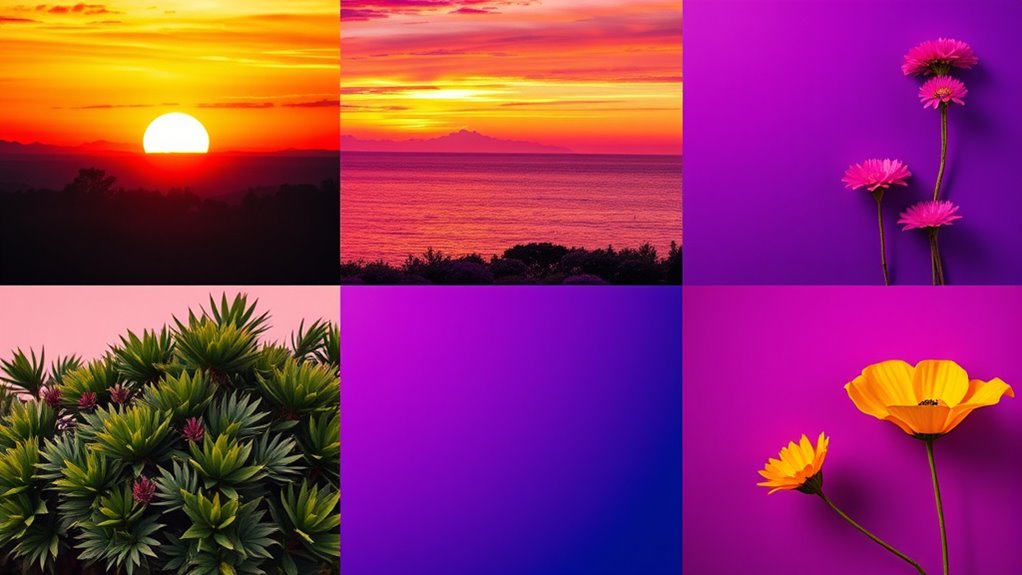To make your social media stand out, use complementary color schemes that create bold contrasts and grab attention. Pairing colors opposite each other on the wheel, like blue and orange or purple and yellow, boosts engagement and makes your content pop. Balancing these hues through saturation and placement prevents visuals from becoming overwhelming. Mastering these schemes helps craft a consistent, visually appealing style that leaves a lasting impression—exploring further reveals how to elevate your designs even more.
Key Takeaways
- Use bold, contrasting color pairs like blue and orange to grab attention and increase engagement on social media posts.
- Maintain visual harmony by balancing saturated and muted complementary hues to prevent overwhelming viewers.
- Consistently incorporate signature complementary schemes to build strong brand identity and recognition across platforms.
- Leverage high contrast between complementary colors to highlight key content, such as calls-to-action or important messages.
- Adjust brightness and placement of complementary colors to create dynamic, eye-catching visuals that stand out in crowded feeds.

Complementary color schemes are a powerful tool in design because they create vibrant, eye-catching contrasts that naturally draw attention. When you use these schemes effectively, you harness the power of color contrast to make your content stand out in a crowded social media landscape. The key lies in understanding how complementary colors—colors opposite each other on the color wheel—interact to produce striking visuals. By pairing these hues thoughtfully, you can craft images and graphics that immediately grab viewers’ eyes and hold their attention. But it’s not just about making things pop; it’s also about maintaining visual harmony. When complementary colors are balanced correctly, they create a sense of dynamic equilibrium that feels both energetic and pleasing. This balance prevents your designs from becoming overwhelming or jarring, ensuring that your audience remains engaged rather than overwhelmed.
In social media, where users scroll through endless feeds, your goal is to catch their eye quickly. That’s where complementary color schemes shine. They offer a natural way to evoke emotion and direct focus. For instance, pairing a deep blue with a bright orange can generate excitement and curiosity, making your post more memorable. When you choose colors with high contrast, your message becomes more legible and impactful. This sharp contrast not only highlights key elements like text or calls-to-action but also adds an aesthetic punch that can elevate your entire brand identity. Achieving visual harmony with complementary colors involves more than just selecting two hues; it requires thoughtful consideration of saturation, brightness, and placement. You want your colors to complement each other without creating chaos, so adjusting shades can help achieve that perfect balance.
Moreover, leveraging complementary color schemes on social media can help establish a distinctive visual style. When your audience starts recognizing your color combinations, it builds familiarity and brand recognition. Consistency in your use of complementary colors makes your content cohesive, even if the images or messages vary. This consistency helps build trust and enhances your overall aesthetic appeal. Remember, the goal isn’t just to be loud but to be memorable in a positive way. When you master the art of contrasting colors while maintaining visual harmony, your social media presence becomes more compelling, engaging, and effective at capturing attention. Ultimately, the strategic use of complementary color schemes allows you to communicate more powerfully, making every visual element count in a crowded digital environment. Recognizing how color contrast influences viewer perception is essential for creating impactful content.
Frequently Asked Questions
How Do Complementary Colors Influence Viewer Emotions?
Understanding how complementary colors influence viewer emotions is key to effective design. Color psychology shows that these contrasting hues create a vibrant emotional response, grabbing attention and evoking excitement or urgency. You can leverage this by choosing complementary colors thoughtfully, as they amplify each other’s effects. This emotional response can make your content more memorable and engaging, helping you communicate your message more powerfully and connect with your audience on a deeper level.
Can Complementary Schemes Be Used Effectively in Branding?
They say a picture is worth a thousand words, and using complementary schemes in branding can back that up. You can boost brand recognition and guarantee color consistency, making your brand stand out. When used effectively, these vibrant contrasts draw attention and leave a lasting impression. Just be mindful of balance, so your design remains harmonious and impactful, reinforcing your brand’s identity with every visual.
What Are Common Mistakes When Using Complementary Colors Online?
When using complementary colors online, you often make mistakes with color contrast that harms visual harmony. You might overdo it, creating harsh, jarring visuals instead of balanced ones. Avoid using too much contrast, which can tire the eyes or make text hard to read. Instead, aim for subtle shifts that enhance visual harmony. Keep your color contrast intentional, ensuring your design stays appealing and easy to look at.
How Do Lighting and Screen Settings Affect Color Perception?
Ever wonder why colors look different on various screens? Lighting and screen settings greatly influence your color perception. Proper display calibration ensures colors stay true, while incorrect lighting can distort them. You might think you’re seeing accurate colors, but poor color calibration and inconsistent lighting can deceive your eyes. To get the most accurate view, regularly calibrate your display and adjust lighting conditions—because your perception of vibrant hues depends on these essential factors.
Are There Cultural Differences in Color Preferences?
You might notice that cultural color symbolism and regional color trends influence your preferences. Different cultures assign unique meanings to colors, shaping what appeals to you. For example, red signifies luck in China, while it can mean danger elsewhere. These cultural influences affect your choices and perceptions, making color preferences vary around the world. So, your favorite colors often reflect your cultural background and regional trends, shaping your visual experiences.
Conclusion
By mastering complementary color schemes, you’ll paint your social media posts with the vibrancy of a rainbow after rain. These color pairs are like dance partners, perfectly synchronized to catch the eye and evoke emotion. When you use them wisely, your visuals won’t just stand out—they’ll shine brighter than a lighthouse guiding lost ships. So go ahead, harness these powerful color combos and watch your content’s impact soar like a bird in full flight.









